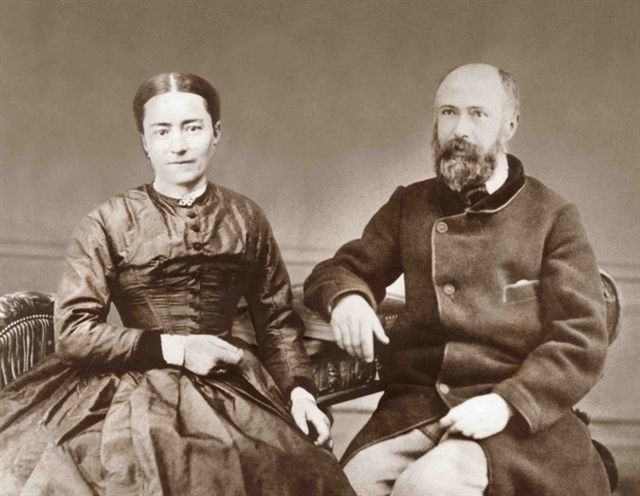It was only in October, 1894, after M. Martin’s death, that M. Guérin, wishing to join in the tomb those whose common life had been a model of conjugal union, transferred the body of his sister to the family vault at Lisieux. The granite tombstone with the funeral inscription that had marked Mme. Martin’s grave at Alencon was then deposited in some free space nearby. Fifty-one years later it was recovered intact and was installed in a good location in the garden of the Pavilion (a small piece of garden with a hexagonal tower owned by the Martin family).
Praises for the memory of Madame Martin were not lacking. Without beating around the bush, the parish priest of Monsort declared that “there was one more saint in heaven.”
Mme. Guérin, who had also received her sister-in-law’s confidence and had many times profited by her experience and her delicate services, will recall her distinguished merits in a letter addressed, fourteen years later, in 1891, to her niece, who has become a Carmelite, Thérèse of the Child Jesus:
"What have I done, then, that God has surrounded me with such loving hearts! I did nothing but answer the last look of a mother whom I loved very much, very much. I believed I understood that look which nothing will be able to make me forget. It is engraved within my heart. Since that day, I have tried to replace her whom God had taken away from you, but, alas! nothing can replace a Mother! However, God has willed to bless my feeble efforts, and today He permits me to receive the affection of these young hearts. He willed that the mother who guided your early childhood be raised to a more sublime glory and enjoy heavenly delights. Ah! it is because, little Thérèse, your parents are among those we may call saints and who merit bringing forth saints.”4
The evaluation of Louise Marais, who lived for twelve years with the Martin family, is no less touching. Mme. Martin, during her illness, was forced to discharge this faithful maidservant, who was a bad influence on Léonie. Louise asked, as a favor, to continue to work for the family until the death of Mme. Martin, claiming that no one could nurse her as well as she could. Indeed, until the end she surrounded the sick woman with the most complete devotion. She moved away then, for the re-education of Léonie demanded it, but she took with her the indelible memory of the one who had shown her so much sweetness. In 1923, some months before dying, she wrote to the Carmel of Lisieux:
In my sharp suffering, I invoke my little Thérèse and, at the same time, her good and holy mother, because, if little Thérèse is a Saint, her mother, in my opinion, is also a saint and a great saint. She was very much tried during her life, and she accepted it all with resignation. And then, how she could sacrifice herself! For herself, anything was good enough, but for others, nothing was good enough. I could say a great deal to you if I told of all her goodness and her submissiveness to the will of the good God.”5
Louder than all these testimonies rises the voice of M. Martin, who never spoke of his wife without attributing to her the qualifier of “saintly;” the voice of the daughters, who, under the oath of faith, affirmed her maternal virtues in their depositions at the Process of Beatification of their little sister. Louder still speaks the youngest. Could there ever be a more beautiful portrait of a mother than this stanza written by Thérèse?
I loved Mama’s smile.
Her deep gaze seemed to say:
“Eternity overwhelms me and attracts me.
I’m going to go up in the blue Sky
To see God!”6
2 1 Story of a Soul, Ms. A, 12v.
2 Story of a Soul, Ms. A, 12v.
3 Story of a Soul, Ms. A, 12v
4 Letters of St. Thérèse of Lisieux, Volume II, 1890-1897, tr. John Clarke, O.C.D. (Washington, D.C.: ICS Publications, 1988), pp. 745-46. Note that the last sentence of the quoted passage is inauthentic.
5 quoted in Story of a Family: The Home of the Little Flower, by Stephane-Joseph Piat, O.F.M., tr. by a Benedictine of Stanbrook. New York: P. J. Kenedy & Sons, 1947., p. 260. Note that I translated this article, "Death of a mama," from an article that appeared in Therese de Lisieux, no. 829, in January 2003. It was only in 2016, searching for the source of this quotation from Louise Marais, that I realized that most of the text of this article is drawn from Story of a Family, so I want to acknowledge that book here. Note that the maidservant Louise Marais was not only a bad influence on Leonie; she beat her and alienated her from her mother. Later Leonie said “I forgive my tormentor, and I am grateful to her for looking after my mother so well during her last illness.”
6 The Poetry of Saint Thérèse of Lisieux, tr. Donald Kinney, O.C.D. (Washington, D.C.: ICS Publications, 1996), PN 18, p. 96).







